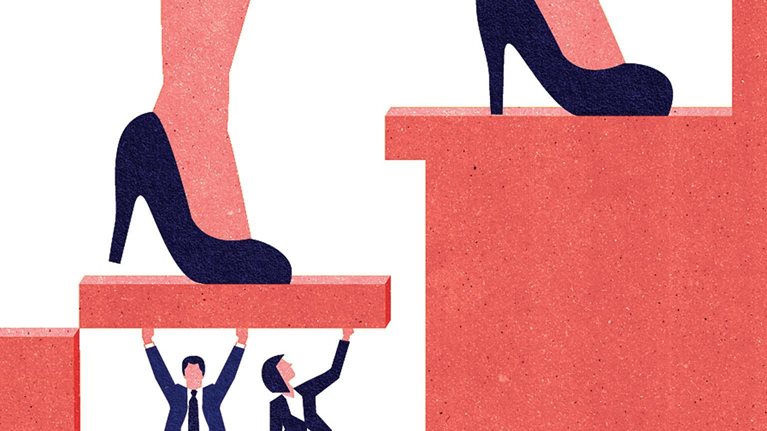Working on films that resonated with female audiences like Thelma and Louise and A League of Their Own heightened my awareness of how few opportunities women have to feel empowered coming out of a movie. But it wasn’t until I had my first child that I noticed a similar problem in children’s media, and its surprising link to the issues that plague us in adulthood.
When my daughter was a toddler, and I started watching little kids’ TV shows and G-rated movies with her, I was thunderstruck by the stunning dearth of female characters. But no one else seemed to be noticing. My friends were completely surprised when I pointed it out. If I happened to be in a meeting with a studio executive or a producer, I would ask them about it and, to a person, they reassured me that the problem had already been fixed. I realized I wouldn’t get anywhere without the numbers. So, I commissioned the largest study ever done on children’s television and films and founded my Institute on Gender in Media, to engage the industry through research, events, and educational programs.
When we present the data to studios and content creators, their jaws are on the ground. In family films, the ratio of male to female characters is 3:1. Shockingly, the ratio of male to female characters has been exactly the same since 1946. Of the characters with jobs, 81 percent are male. Female characters in G-rated animated movies wear the same amount of sexually revealing clothing as female characters in R-rated films, which is simply bizarre if you think about it. And even more baffling, women make up only 17 percent of characters in crowd scenes.
In many segments of society—Fortune 500 boards, law partners, tenured professors, Congress—the percentage of women stalls out at around 17 percent. I don’t think that’s a coincidence. We all grew up watching vast amounts of media with the same ratio. What if we’re conditioned to see 17 percent as the norm?
This fall, we completed the first global study of gender depictions in movies, analyzing 120 films across the ten most profitable film markets.1 The landscape is no less bleak. For speaking or named characters, 31 percent were female—males made up 69 percent. Only 23 percent of films featured a female leading or coleading character. In all, only 10 percent of the films we studied had a gender-balanced cast (where women made up 45 to 55 percent of the characters).
Why life imitates art
One of the most troubling findings of our global study, mirroring our previous research, is that the percentage of fictional women in the workforce is even lower than the one that exists in the real world. In the international films we studied, less than 25 percent of employed characters were female, while women make up 40 percent of the global workforce. Film depictions also fail to reflect the slow but steady progress of female representation across professions. Only 14 percent of C-suite executives portrayed were female, while women comprise 24 percent of senior management globally. Despite women holding 21 percent of global political positions, only 12 female politicians were shown, compared to 115 male officials. In the legal sphere, male judges and lawyers outnumbered females 13 to 1, and in STEM2 fields, the ratio of men to women was 7 to 1. If women are continually depicted as one-dimensional, sidelined, stereotyped, hypersexualized, not given leadership roles or simply absent, it sends a very clear message: women and girls are not as important as men and boys. And that has an enormous impact on business and society.
Images have a profound effect on how we see the world and our role in it. For every hour of television a girl watches, the fewer opportunities she thinks she has in life and the more likely she is to link her physical appearance to self-worth. That psychological ceiling, installed at an early age, continues to influence her decisions as an adult.
Conversely, for every hour of television a boy watches, the more sexist his views become and the more permanently ingrained are society’s narrow expectations for his behavior as well. That’s why I chose to focus on what kids see first. It’s common sense—don’t create a problem that needs to be solved later. Just show kids from the beginning that boys and girls share the sandbox equally, that they do equally interesting things, and that they are half the population. Think of how dramatically different our world could be if children grew up and entered the workforce free from these biases!
Some may argue that the influence of media is exaggerated, but we’ve continually come across examples that confirm just how easily and quickly children incorporate what they see into an understanding of the role of men and women in society. We sponsored a video series called Guess Who?, in which children were told brief stories about a real-life judge, mathematician, or other professional and then asked them to describe what those people looked like. Invariably, both boys and girls immediately described a man, and they were taken aback when the person was revealed to be a woman. Are their responses just a rational reflection of what they see in everyday life—an accurate assumption based on the real-life percentage of women in those roles?
We know that’s not the case; the research shows there are far more women in leadership positions in the real world than the “reel” world. The reality is that a child’s perception of the world is often shaped by what he or she sees in the media, even if that vision can be readily contradicted by observation of the real world. At one of our symposiums a few years ago, a writer for Doc McStuffins, a children’s television show about an African-American girl who plays doctor with her toys, recounted a telling anecdote. A doctor who enthusiastically supported the show was watching an episode with her young son, and at one point he turned to her and asked, “Can boys be doctors, too?”
We can’t ignore the issue of unconscious bias. It’s just in us, planted and reinforced by the media from a very young age. There was a recent study at Yale where scientists were given two versions of the same résumé for a job opening.3 The résumés were identical—except for the candidate’s first name. The “male” candidate was judged to be more talented and experienced; he was selected for the job more often, and at a higher salary. That’s huge—and it happens all the time.
Corporations need to address unconscious bias, or it will flourish under the radar and undermine any reforms you undertake. Like the scientists in the Yale study, people just don’t realize they have unconscious gender bias, so it’s important to bring someone in—like me—to educate the company, top-down. There’s also the external side of it: How are you attracting your customers? How are you presenting yourself, as an organization, to the world? There’s a lot of unconscious negative messaging that can slip in. So examine all aspects of your business, and when making decisions, stop and think, “Have I looked at this with a gender lens? Do I have enough women on my team to have a dialogue that incorporates multiple perspectives?”
For more on the research discussed in this article, see the recent report Gender bias without borders, on the Geena Davis Institute on Gender in Media’s website.

